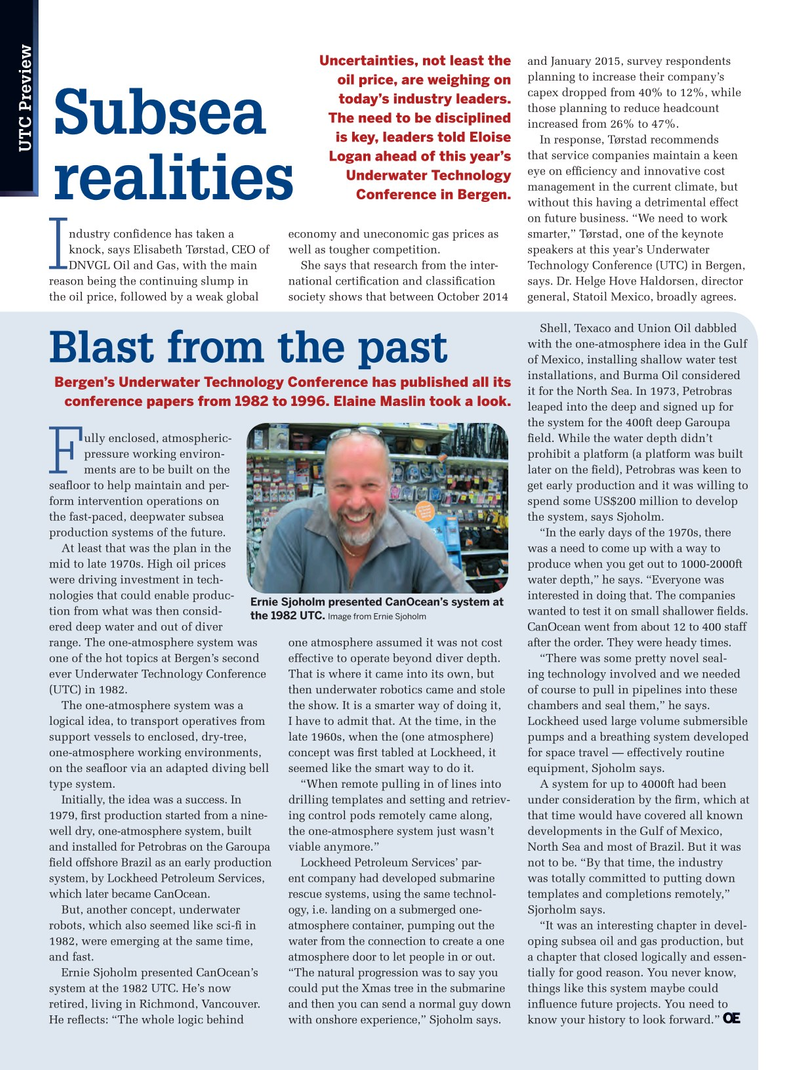
Page 146: of Offshore Engineer Magazine (May/Jun 2015)
Read this page in Pdf, Flash or Html5 edition of May/Jun 2015 Offshore Engineer Magazine
UTC -1 (page one of two)
For OE magazine, May, 2015 [666 (652 submitted) words] [ed index links] www.utc.com [byline] Eloise Logan [images] CREDIT: , director general, Statoil Mexico. Image from Elaine Maslin.
and January 2015, survey respondents
Uncertainties, not least the planning to increase their company’s oil price, are weighing on capex dropped from 40% to 12%, while today’s industry leaders. those planning to reduce headcount
The need to be disciplined increased from 26% to 47%.
Subsea is key, leaders told Eloise
In response, Tørstad recommends
UTC Preview that service companies maintain a keen
Logan ahead of this year’s eye on effciency and innovative cost
Underwater Technology management in the current climate, but
Conference in Bergen. realities without this having a detrimental effect on future business. “We need to work ndustry confdence has taken a economy and uneconomic gas prices as smarter,” Tørstad, one of the keynote knock, says Elisabeth Tørstad, CEO of well as tougher competition. speakers at this year’s Underwater
I
DNVGL Oil and Gas, with the main She says that research from the inter- Technology Conference (UTC) in Bergen, reason being the continuing slump in national certifcation and classifcation says. Dr. Helge Hove Haldorsen, director the oil price, followed by a weak global society shows that between October 2014 general, Statoil Mexico, broadly agrees.
Shell, Texaco and Union Oil dabbled with the one-atmosphere idea in the Gulf
Blast from the past of Mexico, installing shallow water test installations, and Burma Oil considered
Bergen’s Underwater Technology Conference has published all its it for the North Sea. In 1973, Petrobras conference papers from 1982 to 1996. Elaine Maslin took a look.
leaped into the deep and signed up for the system for the 400ft deep Garoupa ully enclosed, atmospheric- feld. While the water depth didn’t pressure working environ- prohibit a platform (a platform was built
F ments are to be built on the later on the feld), Petrobras was keen to seafoor to help maintain and per- get early production and it was willing to form intervention operations on spend some US$200 million to develop the fast-paced, deepwater subsea the system, says Sjoholm. production systems of the future. “In the early days of the 1970s, there
At least that was the plan in the was a need to come up with a way to mid to late 1970s. High oil prices produce when you get out to 1000-2000ft were driving investment in tech- water depth,” he says. “Everyone was nologies that could enable produc- interested in doing that. The companies
Ernie Sjoholm presented CanOcean’s system at tion from what was then consid- wanted to test it on small shallower felds. the 1982 UTC. Image from Ernie Sjoholm ered deep water and out of diver CanOcean went from about 12 to 400 staff range. The one-atmosphere system was one atmosphere assumed it was not cost after the order. They were heady times.
one of the hot topics at Bergen’s second effective to operate beyond diver depth. “There was some pretty novel seal- ever Underwater Technology Conference That is where it came into its own, but ing technology involved and we needed (UTC) in 1982. then underwater robotics came and stole of course to pull in pipelines into these
The one-atmosphere system was a the show. It is a smarter way of doing it, chambers and seal them,” he says. logical idea, to transport operatives from I have to admit that. At the time, in the Lockheed used large volume submersible support vessels to enclosed, dry-tree, late 1960s, when the (one atmosphere) pumps and a breathing system developed one-atmosphere working environments, concept was frst tabled at Lockheed, it for space travel — effectively routine on the seafoor via an adapted diving bell seemed like the smart way to do it. equipment, Sjoholm says.
type system. “When remote pulling in of lines into A system for up to 4000ft had been
Initially, the idea was a success. In drilling templates and setting and retriev- under consideration by the frm, which at 1979, frst production started from a nine- ing control pods remotely came along, that time would have covered all known well dry, one-atmosphere system, built the one-atmosphere system just wasn’t developments in the Gulf of Mexico, and installed for Petrobras on the Garoupa viable anymore.” North Sea and most of Brazil. But it was feld offshore Brazil as an early production Lockheed Petroleum Services’ par- not to be. “By that time, the industry system, by Lockheed Petroleum Services, ent company had developed submarine was totally committed to putting down which later became CanOcean. rescue systems, using the same technol- templates and completions remotely,”
But, another concept, underwater ogy, i.e. landing on a submerged one- Sjorholm says. robots, which also seemed like sci-f in atmosphere container, pumping out the “It was an interesting chapter in devel- 1982, were emerging at the same time, water from the connection to create a one oping subsea oil and gas production, but and fast. atmosphere door to let people in or out. a chapter that closed logically and essen-
Ernie Sjoholm presented CanOcean’s “The natural progression was to say you tially for good reason. You never know, system at the 1982 UTC. He’s now could put the Xmas tree in the submarine things like this system maybe could retired, living in Richmond, Vancouver. and then you can send a normal guy down infuence future projects. You need to
He refects: “The whole logic behind with onshore experience,” Sjoholm says. know your history to look forward.”
May 2015 | OE oedigital.com 148 148_OE0515_UTCPreview.indd 148 4/20/15 10:32 PM

 145
145

 147
147